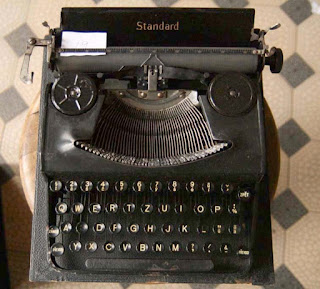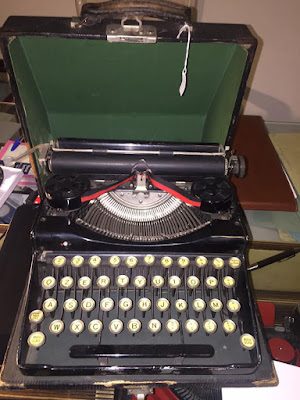The G&O (Graf & Oertel) portable is a minor German make that was marketed with a variety of really obscure names, such as Bajnok, Cawena, Mercurius, Mirina, Rex, and Standard.






I believe this is the only known example of a Garvin index typewriter. It was sold by Auction Team Breker in 2008.

The Gilman is known only from this illustration. Looks like a toy table saw!

Another obscure portable is the Gloria. This is #4189, with an Italian keyboard.

The Blick 90 and Voss Privat were also sold under the name Gloria.


I filed this one under G for Gundka, but it seems to be a British copy of the German Gundka, with a little plaque naming Enoch Jones & Sons. Maybe they were just the British distributors.


The decals on this Hansa (Franz Pehmer collection) are eye-catching. I believe the ribbon cover is missing and that this is a name variant of the Culema.

The Helma is another minor German typewriter with a fabulous decal. This is #655, from Thomas Fürtig's collection.

The Hispania is a very rare machine from (you guessed it) Spain. Some more information can be found in ETCetera No. 86 (p. 6). This is #1204 in the Sirvent collection.

This is a Hughes—or a replica of one?

IBM isn't exactly a little-known make, but a Siamese twin IBM Model C? That's obscure. The purpose of this invention, presumably, was to type in two different alphabets—a job that the Selectric made considerably easier.

This oblique frontstroke typewriter is an Imperial (an American make, not to be confused with the British Imperial). Very few collectors have seen one of these.

Here and in other installments of this series, I'm focusing on typewriters that are infrequently noticed or discussed among collectors, and am leaving out some very rare machines that are on the radar of serious collectors already, such as the Garbell, Gardner, Granville, Hammonia, Hartford, Hogar, Ingersoll, and International. But if you want me to post photos of any of them, let me know and I'll do so in the next installment.






I believe this is the only known example of a Garvin index typewriter. It was sold by Auction Team Breker in 2008.

The Gilman is known only from this illustration. Looks like a toy table saw!

Another obscure portable is the Gloria. This is #4189, with an Italian keyboard.

The Blick 90 and Voss Privat were also sold under the name Gloria.


I filed this one under G for Gundka, but it seems to be a British copy of the German Gundka, with a little plaque naming Enoch Jones & Sons. Maybe they were just the British distributors.


The decals on this Hansa (Franz Pehmer collection) are eye-catching. I believe the ribbon cover is missing and that this is a name variant of the Culema.

The Helma is another minor German typewriter with a fabulous decal. This is #655, from Thomas Fürtig's collection.

The Hispania is a very rare machine from (you guessed it) Spain. Some more information can be found in ETCetera No. 86 (p. 6). This is #1204 in the Sirvent collection.

This is a Hughes—or a replica of one?

IBM isn't exactly a little-known make, but a Siamese twin IBM Model C? That's obscure. The purpose of this invention, presumably, was to type in two different alphabets—a job that the Selectric made considerably easier.

This oblique frontstroke typewriter is an Imperial (an American make, not to be confused with the British Imperial). Very few collectors have seen one of these.

Here and in other installments of this series, I'm focusing on typewriters that are infrequently noticed or discussed among collectors, and am leaving out some very rare machines that are on the radar of serious collectors already, such as the Garbell, Gardner, Granville, Hammonia, Hartford, Hogar, Ingersoll, and International. But if you want me to post photos of any of them, let me know and I'll do so in the next installment.


Keep 'em coming! Now I sort of regret what I said to you about uploading these long ago. :D
ReplyDeleteThe Graf & Oertel varieties appear to be intended for various foreign markets—Bajnok and Cawena are starkly non-Germanic names, and the Bajnok has a (probably accented) E where you would expect the ö to be on a QWERTZ keyboard. The Mercurius seems meant for the British, judging from the QWERTY layout and the sterling symbol to the right of the L. But what language is that on the right shift key? Dutch?
ReplyDeleteYes it is. Wissel-toets os literally changing key or shifting key. Sometimes abbreviated as WT, mostly on German-made machines. The Mercurius also has the Dutch 'ij' and the stylised 'f' for the Florin.
DeleteThe Bajnok is Hungarian. The word means "champion."
DeleteExcellent series really!
ReplyDelete